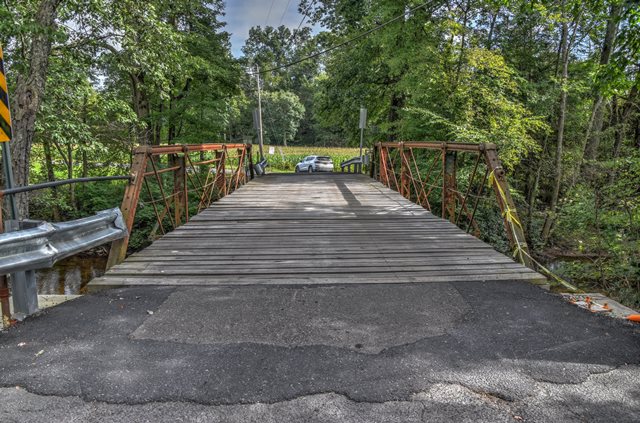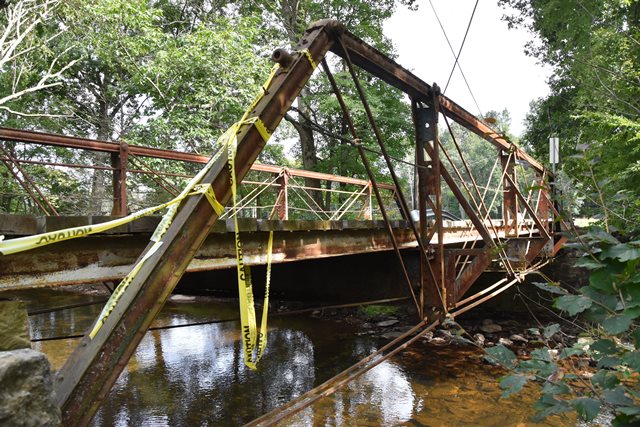We Recommend:
Bach Steel - Experts at historic truss bridge restoration.
Walp Road Bridge

Primary Photographer(s): Nathan Holth
Bridge Documented: November 19, 2010 and August 26, 2019
Rural: Luzerne County, Pennsylvania: United States
1889 By Builder/Contractor: Phoenix Bridge Company of Phoenixville, Pennsylvania, Dean and Westbrook of New York, New York, Agents
2004
60.0 Feet (18.3 Meters)
62.0 Feet (18.9 Meters)
16 Feet (4.88 Meters)
1 Main Span(s)
40723003427312

View Information About HSR Ratings
Bridge Documentation
View Archived National Bridge Inventory Report - Has Additional Details and Evaluation
This bridge is one of several rare examples in Luzerne County of a pony truss bridge employing the distinctive Phoenix Column in its truss members, specifically the top chord and end post. Although a relatively short span example, short-span pony truss bridges with Phoenix columns do not appear to be any more common than through truss examples, and indeed the pony truss examples may be more rare. Luzerne County may have the largest surviving population of Phoenix pony truss bridges in the entire country! Indeed, all surviving truss bridges with Phoenix columns should be assigned a very high level of historic significance regardless of truss size or configuration. This bridge was constructed by bridge builder Dean and Westbrook, one of the more prolific connoisseurs of bridges fabricated by Phoenix Bridge Company. The bottom chord is located below the floorbeams, an uncommon detail. All but one of the original pole railings is missing on the bridge. Some of the vertical members have had various repairs made to them, and/or suffered from minor impact damage, including older pre-2010 impacts and more recent ca. 2019 damage to approach pipe guardrail that attached to the end post of the truss. However the top chord and end post Phoenix columns, and indeed the bridge as a whole remains and appears largely unaltered from its original design, thus the significance of the bridge remains very high.
Information and Findings From Pennsylvania's Historic Bridge InventoryDiscussion of Bridge The single span, 63'-long, pin-connected, wrought iron Pratt pony truss bridge built in 1889 is supported on stone abutments. The bridge is composed of Phoenix section upper chords with cast-iron connecting pieces, built-up verticals, and eye bar diagonals and lower chords. Built-up floorbeams and rolled stringers support the timber deck. The bridge was fabricated by the Phoenix Bridge Co. of Phoenixville, PA, and erected by their agents Dean & Westbrook of New York. The company was instrumental in refining and popularizing metal truss bridge technology during the last half of the 19th century. The Phoenix column, patented in 1861, was one of the first successful attempts to substitute built-up wrought iron sections for cast iron for use with compression members. Truss bridges with Phoenix column members were used widely by railroads through the mid 1880s and for highway applications through the mid 1890s. It is mostly the later highway examples, such as this 1889 bridge, that have survived in small numbers in Pennsylvania. The bridge is historically and technologically distinguished. The single span, 62'-long, wrought iron, pin-connected, Pratt pony truss bridge is supported on masonry abutments. The bridge was built by Dean & Westbrook using Phoenix sections for the upper chords and inclined end posts and standard design Phoenix Company connecting pieces and bearings along with details that are particular to Dean & Westbrook. The roadway width is 16'- 2” and the overall deck width is 16'- 4”. This is not a standardized design Pratt pony truss bridge, and it represents Dean & Westbrook’s innovative thinking about features intended to provide a stronger bridge with the most economical use of material. The verticals are composed of angles with lacing. Pin plates are used to make their connection at the cast iron upper chord connecting pieces. The deep, built up floorbeams are framed into the bottom portion of the verticals above the eyebar lower chords. There are punched pin holes in each vertical for the lower panel point connection. Placing floorbeams above the lower chords is not common in Pratt pony truss bridges. A triangular-shaped riveted outrigger is present at both ends of each floorbeam that meets the vertical at about its midpoint. The diagonals are eyebars, and the counters are bar stock and Dean & Westbrook’s cast open loop heads. All but one of the original pipe railings have been lost, replaced by a steel cable set inside the truss lines. The deck is timber planks, and the abutments and wingwalls are fieldstone. Although there is no plaque on the pin connected 1915 Pratt pony truss bridge with Phoenix section upper chords and inclined end posts, it has the same distinctive details and design variations as 40 7217 0482 6006 (Bridge Key No. 24411) that has a plaque identifying it as built in 1889 by Dean & Westbrook, Engineers and Contractors. Dean & Westbrook were the agents for marketing and building highway bridges for the Phoenix Iron Company. They are also noted for innovative designs, including at least six remaining examples of this one in Luzerne and Chester counties and the English Center (Lycoming County) hybrid design placed in 1891. The bridge has high technological significance because of its distinctive details representing the era of experimentation in metal truss bridge design and the use of Phoenix sections, which did as much as any detail to prove the value of metal truss bridges during the last half of the 19th century. The cast- and wrought-iron bridge provides an important snapshot of thinking about bridge design and fabrication prior to steel and standardization. All bridges with Phoenix section members have at least a high historic significance level. This bridge is nearly identical to 40 7217 0482 6006 (Bridge Key No. 24411) that has an exceptional level of historic significance but was built 26 years previous. The character-defining features include the truss form and method of truss member end connection (pin connected Pratt Pony truss with the eye bar lower chords connected to the verticals by pin plates), the Phoenix section upper chords and inclined end posts, and the floorbeam connection detail (floorbeams framed into the bottom portion of the verticals above the eyebar lower chords). Discussion of Surrounding Area The single lane bridge carries a 2 lane road over a stream in a rural setting of woods, active farms, and scattered 19th to late 20th century houses. The setting does not have the cohesiveness or integrity of a historic district. The single lane bridge carries a single lane, rural road over a stream, in a rural setting with woodlands, active agriculture, and scattered houses. The bridge is south of a T intersection with Kisenwether Road. The 16'-2" wide bridge roadway is slightly narrower than the 17’± wide minimum maintained approach roadway. The bridge and road have a very low reported traffic volume (ADT 150). Bridge Considered Historic By Survey: Yes |
This bridge is tagged with the following special condition(s): Phoenix Columns
![]()
Photo Galleries and Videos: Walp Road Bridge
2010 Bridge Photo-Documentation
Original / Full Size PhotosA collection of overview and detail photos. This gallery offers photos in the highest available resolution and file size in a touch-friendly popup viewer.
Alternatively, Browse Without Using Viewer
![]()
2010 Bridge Photo-Documentation
Mobile Optimized PhotosA collection of overview and detail photos. This gallery features data-friendly, fast-loading photos in a touch-friendly popup viewer.
Alternatively, Browse Without Using Viewer
![]()
2019 Bridge Photo-Documentation
Original / Full Size PhotosA collection of overview and detail photos. This gallery offers photos in the highest available resolution and file size in a touch-friendly popup viewer.
Alternatively, Browse Without Using Viewer
![]()
2019 Bridge Photo-Documentation
Mobile Optimized PhotosA collection of overview and detail photos. This gallery features data-friendly, fast-loading photos in a touch-friendly popup viewer.
Alternatively, Browse Without Using Viewer
![]()
Maps and Links: Walp Road Bridge
Coordinates (Latitude, Longitude):
Search For Additional Bridge Listings:
Bridgehunter.com: View listed bridges within 0.5 miles (0.8 kilometers) of this bridge.
Bridgehunter.com: View listed bridges within 10 miles (16 kilometers) of this bridge.
Additional Maps:
Google Streetview (If Available)
GeoHack (Additional Links and Coordinates)
Apple Maps (Via DuckDuckGo Search)
Apple Maps (Apple devices only)
Android: Open Location In Your Map or GPS App
Flickr Gallery (Find Nearby Photos)
Wikimedia Commons (Find Nearby Photos)
Directions Via Sygic For Android
Directions Via Sygic For iOS and Android Dolphin Browser
USGS National Map (United States Only)
Historical USGS Topo Maps (United States Only)
Historic Aerials (United States Only)
CalTopo Maps (United States Only)



